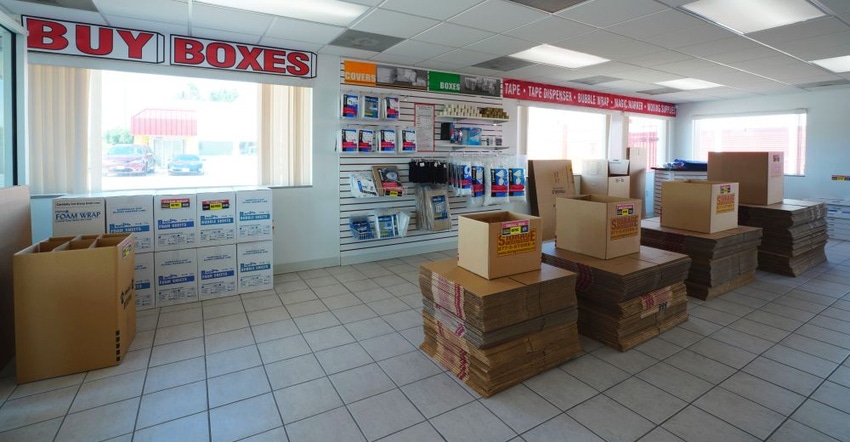The Tremendous Value of Self-Storage Retail: How to Choose Products, Display Items and More
When a customer rents self-storage, they almost always need other things, too, like a good lock for their unit door and supplies to help them pack, move and protect their goods. This is why a retail program can bring such tremendous value to your business. Learn what items to sell, how to display them, how to choose a vendor and more.

In most cases, if you have a customer who’s ready to rent self-storage unit, you don’t send them down the street to a competitor, do you? You want to keep that business for yourself! So why would you send people elsewhere to buy retail products like door locks, boxes and other items they need to pack, move and protect their goods?
When someone rents storage, there’s a high likelihood they need other things, too. It makes sense to meet those needs rather than pass up additional profit. Stocking products that enhance the customer’s moving and storage experience is more than just a way to generate revenue. You’re offering convenience and value. Let’s explore what’s involved with setting up an enticing, profitable retail program.
Choosing Products
In self-storage, facility operators typically see about 80% of their retail business come from 20% of their products—their best-sellers. To determine what you should carry, it’s helpful to know what’s trending nationwide. Here’s what your customers are currently buying:
Locks: Offer a variety of types and educate tenants about them.
Boxes: Keep an assortment of sizes on hand.
Tape: Carry different styles and lengths.
Protective packaging: Bubble wrap, foam packaging and packing paper are the key items customers need.
Furniture covers: Sofa and mattress covers are in high demand.
Moving blankets: These are good to protect nearly anything.
Door locks and moving supplies will fill your customers’ core needs, but consider adding impulse items, too. You can keep these small, inexpensive products near your checkout. When the right product catches their eye, customers will often add an extra item at the point of sale without much thought. These are popular:
Cell phone accessories: Cables, wall chargers and headphones are some of the common items that get lost or buried during a move.
Clip-on lights: These convenient gadgets help tenants see inside their units at any time.
Carabiners: These have a range of uses, like holding or clipping items together.
Merchandising
Once you have the items you wish to sell in your self-storage retail center, your merchandising displays can help or hinder sales. The goal is to display items in an attractive manner that quickly catches attention. Here are a few key points to remember:
Keep displays fresh! Make sure products are undamaged and free from dust.
Don’t be afraid to use technology. Digital displays can help customers connect with products.
Signage is a must. Make sure customers can easily find products and understand the use of each.
Help with visualization. Set up demos for products that may be hard to envision in their packaged state. For example, a folded box or dish pack doesn’t make much of an impression until built. Display one of each product in its final form.
Offer bundles. Group key items together. A set of boxes with tape is an attractive item that offers a convenient purchase.
If you’re overwhelmed with options and unsure how to organize items, ask your supplier about premade planograms, which can help you quickly assemble an effective display. Many providers offer these in a range of sizes to accommodate the products you carry.
Just don’t forget the importance of staff involvement. Even the best display in the world amounts to little if your facility manager isn’t friendly and welcoming, armed with great product knowledge. They must be willing to interact with customers and answer questions that help match your retail products to their individual needs.
It’s also crucial to keep an eye on inventory and have a restock plan. In addition to tracking quantities via computer, many facility operators find it beneficial to use physical reorder tags. Maintaining the right product levels is vital, and bad inventory management can cost you time and money. Without a proper system in place, you’ll disappoint customers and miss out on sales.
Finding a Partner
Once you have an idea of what you want to stock in your self-storage retail center, find a reputable supplier that can fulfill your needs. Some vendors offer only print catalogs from which to choose products, while others have more robust solutions, such as custom, online portals with budget controls.
A great way to meet and vet suppliers is to attend industry tradeshows. You can get a glimpse of their product mix and speak face-to-face with representatives. Of course, you can also search the web and peruse industry-specific online directories.
One careful consideration these days are the challenges (delays) occurring within the global supply chain. It’s important that you can order and receive products when you need them, so pick a supplier you trust.
Meeting Customers Where They Are
Once you get set up your self-storage retail program and have an effective system in place, you’ll quickly see how easy it is to sell items to your uniquely captive audience. Customers are checking a lot of mental checklists during whatever life event has brought them to your facility. They’ll appreciate the convenience of being able to buy items that’ll simplify their move and enhance their storage experience. And you’ll appreciate the added value retail brings to your bottom line!
Jamie Runevitch is the marketing manager of Supply Side USA, a provider of packaging, shipping and moving retail products to self-storage facilities, parcel service centers and specialty retailers. She has more than seven years of experience in marketing and graphic design. For more information, call 800.284.7357.
About the Author(s)
You May Also Like





